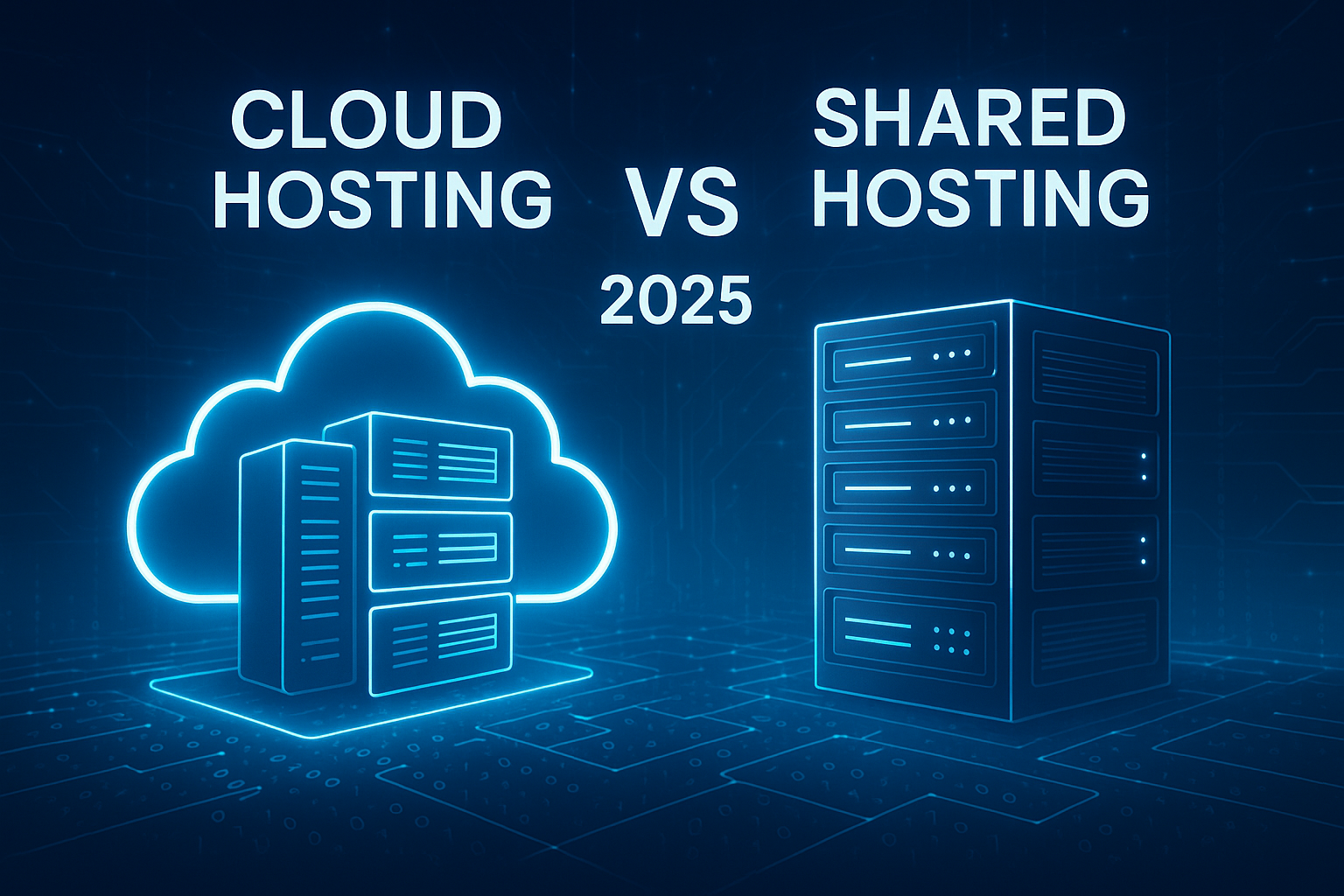
☁️ Introduction
Choosing the right hosting service can make or break your website in 2025.
Whether you run an e-commerce store, a personal blog, or a digital startup — your hosting choice determines your site’s speed, security, uptime, and scalability.
For years, shared hosting was the most popular and affordable choice. But now, with advanced cloud technologies becoming mainstream, cloud hosting has taken over as a serious competitor.
So which one is truly better in 2025 — Cloud or Shared Hosting?
Let’s break down the pros, cons, and best use cases so you can make the smartest decision for your website.
🧠 1. What Is Shared Hosting?
Shared hosting is the traditional web hosting model, where multiple websites share the same server and resources — like CPU, RAM, and bandwidth.
It’s like renting a single apartment with several roommates — you all share utilities and space.
✅ Pros of Shared Hosting
- Affordable: Cheapest hosting option for beginners.
- Easy to manage: Most plans come with cPanel and one-click installations.
- Beginner-friendly: No technical setup needed — great for small blogs or static websites.
❌ Cons of Shared Hosting
- Limited resources: Other websites on the server can slow down your site.
- Security risks: Shared environments are more vulnerable to attacks.
- Low scalability: Can’t handle sudden spikes in traffic.
- Performance issues: Ideal only for low-traffic websites.
💡 Best for: Personal blogs, small portfolios, or static sites with limited traffic.
☁️ 2. What Is Cloud Hosting?
Cloud hosting uses a network of interconnected servers to host your website instead of one single server.
It’s like having multiple backup engines running your site — if one fails, another instantly takes over.
✅ Pros of Cloud Hosting
- Scalability: Easily handle traffic spikes without downtime.
- Reliability: Your site stays online even if one server fails.
- Speed: Uses advanced caching and load balancing to deliver faster performance.
- Pay-as-you-go: You only pay for the resources you use.
- Security: Isolated virtual environments reduce hacking risks.
❌ Cons of Cloud Hosting
- Slightly higher cost: More expensive than shared hosting (but worth it).
- Requires basic tech knowledge: Advanced settings may confuse beginners.
💡 Best for: E-commerce stores, SaaS platforms, business websites, and growing blogs.
⚙️ 3. Key Differences Between Cloud and Shared Hosting
| Feature | Shared Hosting | Cloud Hosting |
|---|---|---|
| Performance | Slower (shared resources) | Fast & optimized (dedicated resources) |
| Uptime | 95–98% | 99.99% (auto failover) |
| Security | Moderate, shared environment | High, isolated virtual servers |
| Scalability | Very limited | Highly scalable |
| Cost | Budget-friendly ($2–5/month) | Mid-range ($5–20/month) |
| Management | Simple, beginner-level | Advanced, professional-level |
| Traffic Handling | Low to medium | Medium to high |
| Ideal For | New or small sites | Businesses, high-traffic, or global websites |
⚡ 4. Why Cloud Hosting Is Winning in 2025
As more websites rely on high-speed performance, automation, and data storage, cloud hosting is dominating the web industry.
Here’s why:
- AI and machine learning integration: Cloud servers use AI to auto-optimize performance.
- Edge computing: Brings data closer to users for lightning-fast load times.
- Eco-friendly hosting: Uses energy-efficient data centers, reducing carbon footprint.
- Seamless scalability: Perfect for websites that grow quickly or experience seasonal spikes.
📈 Fact: Over 70% of new websites in 2025 use cloud hosting because of its reliability and performance.
💰 5. Pricing Comparison (2025 Update)
| Provider | Shared Hosting (Monthly) | Cloud Hosting (Monthly) |
|---|---|---|
| Bluehost | $2.95 | $9.95 |
| Hostinger | $1.99 | $7.99 |
| SiteGround | $3.99 | $10.49 |
| A2 Hosting | $2.99 | $11.99 |
| Cloudways | N/A | $14.00 |
💡 Note: Prices vary based on region, bandwidth, and storage requirements.
🔐 6. Security & Data Protection
Security is a top priority in 2025. Shared hosting environments are more vulnerable because if one site gets hacked, others on the same server might be affected.
Cloud hosting, on the other hand, offers isolated virtual machines, SSL encryption, and automated backups. Many providers also include built-in DDoS protection and malware scanning.
If your website handles sensitive customer data or payment info, cloud hosting is the safer choice.
🚀 7. Speed & Performance
In shared hosting, your website competes for CPU and bandwidth with hundreds of others.
If one site experiences high traffic, your site slows down.
Cloud hosting distributes your data across multiple servers, ensuring:
- Faster loading times.
- Zero downtime during traffic spikes.
- Global CDN (Content Delivery Network) integration for speed consistency worldwide.
⚙️ Pro Tip: Combine cloud hosting with an SSD server and caching plugin for lightning performance.
🌐 8. Which Hosting Is Best for You?
Here’s a quick guide:
- Choose Shared Hosting if:
- You’re just starting your website or blog.
- You have limited technical knowledge.
- You’re on a tight budget.
- Choose Cloud Hosting if:
- You run a growing business or online store.
- You expect traffic growth or global visitors.
- You want better security, speed, and uptime.
💬 Verdict: For long-term growth and reliability, Cloud Hosting is the future of web hosting in 2025.
🏁 Conclusion
Both shared and cloud hosting have their advantages — but the future is clearly moving toward cloud solutions.
As AI, automation, and online demand continue to grow, businesses need hosting that’s fast, scalable, and secure — and cloud hosting delivers exactly that.
“In 2025, your website deserves hosting that grows with you — not one that holds you back.”
If you’re serious about performance and long-term growth, invest in cloud hosting — it’s the smart move for modern websites.



